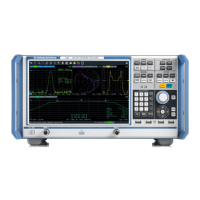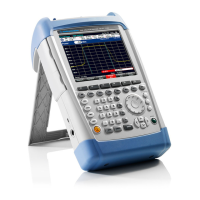Understanding the R&S SGMA-GUI Software
R&S
®
SGS100A
68User Manual 1173.9105.02 ─ 12
3. To load settings from a file, select "SGMA-GUI main panel > File > Open"
4. Navigate to the directory the file is stored in and select the setting file.
The saved settings are loaded to the R&S SGMA-GUI and the main panel of the
software displays the saved instrument's configuration.
6.4.2 Handling Instruments in the R&S SGMA-GUI
This section provides information on how to configure and manage instruments in the
R&S SGMA-GUI.
For reference information about all provided settings in the user interface, refer to the
corresponding sections:
●
Chapter 6.1.2.1, "Configure Instruments", on page 55 and Chapter 6.1.2.2, "Add/
Edit Instruments", on page 57
●
Chapter 6.1.2.3, "Versions/Options Dialog", on page 59
Chapter 6.1.2.5, "Reset SGMA-GUI", on page 61
6.4.2.1 How to Automatically Add New Instruments to the SGMA-GUI
1. For each new instrument perform the following steps:
a) Connect the instrument to the network.
b) Switch on the instrument.
c) Press the [ID] key on the front panel of the instrument.
2. Start the SGMA-GUI on a computer connected to the same network.
All instruments are added automatically to the main panel of the SGMA-GUI.
6.4.2.2 How to Manually Add New Instruments to the SGMA-GUI
1. In the R&S SGMA-GUI main panel, select "Setup > Instruments".
The Configure Instruments dialog opens.
2. Select the "New" button.
The Add Instrument dialog opens to register a new instrument.
3. In the "Symbolic Name" field, enter an alias name of your choice, e.g.
SGS-100021.
4. In the "Instrument Type" field, select the device family to connect to.
5. Select "Remote Control > Hardware Channel" and select the hardware interface.
6. For LAN or Socket interfaces, select "Remote Control > Instrument Name / IP
Address" and enter the IP Address or the hostname of the connected instrument,
e.g. rssgs100a100021.
Working with R&S SGMA-GUI

